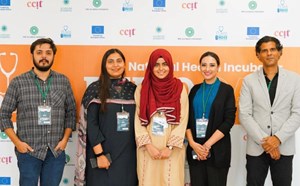
Sounding Hope: Advancing Maternal-Fetal Health in Cameroon Through Point-Of-Care Ultrasound Training
Authors: Scott Bepple1, Jennifer Bepple, MD, MMCi1,2, Georges Bwelle3, Carol McCammon, MD, MPH4
Affiliations:
- MedTech Consulting, Columbia, MD
- OhanaOne, Los Angeles, CA
- Lecturer, Faculty of Medicine University of Yaounde. Cameroon
- Eastern Virginia Medical School, Norfolk, VA
Background
Over 95% of all maternal deaths occur in underdeveloped countries. Of those deaths, 75% of them are preventable. Due to the low access to healthcare in these areas, prenatal screenings are rare. The World Health Organization (WHO 2024) recommends nations have a maternal mortality rate no greater than 70:100,000. The rate in Cameroon is more than six times this rate.1
Several countries have made notable progress in reducing maternal mortality rates, with Ethiopia serving as a significant example. With over 80% of its population residing in rural areas with limited access to healthcare, Ethiopia has historically faced one of the highest maternal mortality rates globally. However, thanks to improved infrastructure and the implementation of the Health Extension Program (HEP), the country achieved a reduction in maternal and neonatal mortality by 72% and 44% respectively from 2000 to 2020.² In a collaborative effort funded by USAID, along with the Ministry of Health and GE Healthcare, limited obstetric ultrasound services were introduced in 120 health centers across Ethiopia. This initiative led to a statistically significant increase in the receipt of skilled birth attendance, as well as antenatal and postnatal care.³ A study evaluating the impact of introducing point-of-care ultrasound (POCUS) in Ethiopia reported, “There was a significant increase in delivery service use in the institution because of the obstetric ultrasound service introduction [POCUS]....Detection of danger signs with obstetric ultrasound makes the mother cautious about her health and seek more health services and deliver in a health facility.”⁴ A similar initiative is being proposed for rural regions in Cameroon.
The American College of Radiology and American College of Obstetrics and Gynecology support women obtaining an ultrasound between 11-14 weeks gestational age to measure nuchal translucency and assess for aneuploidy and other early fetal anomalies. An additional anatomy scan is considered the standard of care between 18-22 weeks gestational age. Unfortunately, in these remote areas, many women do not receive these important tests.5,6
Point of Care Ultrasound (POCUS) is a handheld portable ultrasound device that allows for scans in remote locations because of its size, cost, and ease of use.7 The cost of these devices are on average 90% less than a typical card ultrasound machine.8 Furthermore, POCUS has been shown to improve referral decisions and can be instrumental in improving the quality of care in remote regions.8
Methods
With a generous grant provided by OhanaOne, a ButterflyTM POCUS was purchased to support improved prenatal care in Cameroon. Six clinicians were trained during a comprehensive two-day in-person course. Training consisted of prepared didactic lectures delivered by local radiologists from Yaounde on gynecologic and obstetrical ultrasound and its use in detecting pathology. Both morning didactic sessions were followed by hands-on proctored POCUS training and live volunteers in the second and third trimesters of pregnancy. The live training focused on the technical use of the POCUS and its functionality and documentation workflows. Additionally, trainees were introduced to a systematic approach to a focused basic obstetric ultrasound examination in pregnancy to detect life threatening antenatal conditions through practical assessment of fetal viability (cardiac activity), number of fetuses, fetal presentation, placental location and position, amniotic fluid volume, and fetal biometrics including head circumference, biparietal diameter, abdominal circumference and femur length. This process allows the clinicians to assess the need for escalation of identified potential complications from the rural setting to a higher appropriate level of care for evaluation and assisted delivery planning, as indicated.
A survey was completed to obtain demographic information and to assess the comfort of the clinicians with POCUS pre- and post-training. A subjective measure of confidence was assessed in the following skills: identifying the correct probe, adjusting gain and depth, diagnosing a 3rd trimester fetal presentation, number of fetuses, fetal cardiac activity, placental location, amniotic fluid volume, head circumference, biparietal diameter, and fetal length.
Results
Demographics:
- 33% of trainees were nurses and 33% were midwives.
- On average, the trainees were in practice for over 6 years.
- All trainees see more than 20 patients per week.
- 66% of trainees had no experience with POCUS previously.
- The most common barrier for not performing POCUS previously was the lack of a machine.
Training Impact:
- All subjective confidence levels improved after training.
- Four measures reached statistical significance in improvement, including the measurement of crown-rump length in the 1st trimester, sac length, amniotic fluid volume, and the presence or absence of a 2nd trimester intrauterine pregnancy.
- All agree or strongly agree that they plan to incorporate what they learned into their practice.
- The most common post-training suggestion was for more hands-on training.
Limitations:
- Small number of trainees
- Long-term follow-up and clinical outcomes are currently unavailable.
Conclusion
In conclusion, the implementation of POCUS training in Cameroon has demonstrated significant potential to enhance prenatal care practices among healthcare providers, particularly nurses and midwives. With 66% of the participants lacking prior experience with POCUS, the training successfully improved subjective confidence levels and achieved statistically significant improvements in some critical ultrasound measurements. This suggests that focused educational interventions can effectively empower healthcare workers to overcome barriers related to equipment access and technical proficiency. Critical feedback from participants included the desire for additional hands-on training.
Despite the promising outcomes, the study's limitations, including the small number of trainees and the absence of long-term follow-up data, highlight the need for continued evaluation. Future initiatives, such as additional training sessions and the integration of virtual reality support, aim to sustain skill development and foster connections with international experts. These efforts underscore a commitment to not only enhancing clinical skills but also to potentially shifting cultural practices toward hospital-based deliveries, which aligns with the World Health Organization's emphasis on the importance of skilled birth attendance for improving maternal and newborn health outcomes.9
Overall, the program's initial success is a crucial step toward reducing maternal and fetal mortality in Cameroon. By equipping healthcare providers with the necessary tools and knowledge, we can contribute to the broader goal of ensuring all women receive high-quality care during pregnancy and childbirth, ultimately fostering healthier communities.
References
- Maternal mortality. World Health Organization. Accessed April 24, 2025. https://www.who.int/news-room/fact-sheets/detail/maternal-mortality.
- Melesse DY, Tadele A, Mulu S, et al. Learning from Ethiopia's success in reducing maternal and neonatal mortality through a health systems lens. BMJ Glob Health. 2024;9(Suppl 2):e011911. Published 2024 May 6. doi:10.1136/bmjgh-2023-011911
- Abawollo HS, Argaw MD, Tsegaye ZT, et al. Institutionalization of limited obstetric ultrasound leading to increased antenatal, skilled delivery, and postnatal service utilization in three regions of Ethiopia: A pre-post study. PLoS One. 2023;18(2):e0281626. Published 2023 Feb 15. doi:10.1371/journal.pone.0281626
- Yitbarek K, Tuji A, Alemayehu YK, et al. Effect of USAID-funded obstetric ultrasound service interventions on maternal and perinatal health outcomes at primary healthcare facilities in Ethiopia: a propensity score matching analysis. BMJ Open. 2022;12(10):e065351. Published 2022 Oct 11. doi:10.1136/bmjopen-2022-065351
- Expert Panel on GYN and OB Imaging, Simpson L, Maturen KE, et al. ACR Appropriateness Criteria® Nuchal Translucency Evaluation at 11 to 14 Weeks of Gestation. J Am Coll Radiol. 2020;17(11S):S447-S458. doi:10.1016/j.jacr.2020.09.007
- Expert Panel on GYN and OB Imaging, Sussman BL, Chopra P, et al. ACR Appropriateness Criteria® Second and Third Trimester Screening for Fetal Anomaly. J Am Coll Radiol. 2021;18(5S):S189-S198. doi:10.1016/j.jacr.2021.02.017
- Burleson, S.L., Swanson, J.F., Shufflebarger, E.F. et al. Evaluation of a novel handheld point-of-care ultrasound device in an African emergency department. Ultrasound J 12, 53 (2020). https://doi.org/10.1186/s13089-020-00200-8
- Wanjiku GW, Bell G, Kapadia S, Wachira BW. Impact of point-of-care ultrasound use on patient referral decisions in rural Kenya: a mixed methods study. BMC Health Serv Res. 2024;24(1):212. Published 2024 Feb 15. doi:10.1186/s12913-024-10673-1
- Maternal mortality. World Health Organization. Accessed April 24, 2025. https://www.who.int/news-room/fact-sheets/detail/maternal-mortality.



